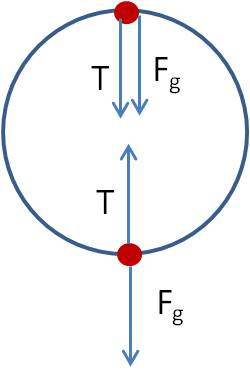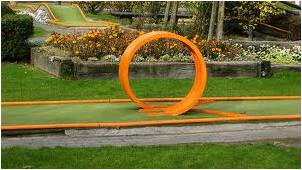In order for an object to move in a uniform circular path, the net force on the object must be mv2/r. Draw the FBD, and any forces not pointed along a radius of the circle must cancel out. All the remaining forces must add up to mv2/r.
Example 1: You attach a ball to the end of a rope and swing it around vertically in a circle. If the rope is 0.50 m long, the ball has a mass of 0.50 kg, and the ball is traveling at a constant speed of 6.0 m/s, what is the tension in the rope at the bottom of the circle? At the top of the circle?
Solution: The FBD is shown for the ball at the bottom of the circle and at the top (I’ve shown the ball in its orbit, but left out the rope to make the picture clearer). Let’s solve the bottom case first.
The net force is T– Fg. Since the ball is traveling in a circle, the net force must be the centripetal force that keeps the ball in a circle, so
Finding the solution at the top of the circle is just as simple:
Note that in problems like this one, the tension is greatest at the bottom and a minimum at the top.
Example 2 : One of the obstacles at your favorite miniature golf course is a loop-the-loop as seen in the picture below. What is the minimum velocity necessary for the golf ball to stay in contact with the loop-the-loop at the top of the loop? The loop has a radius of 1.0 m.
Solution: Draw an FBD of the situation.
The two forces on the golf ball are the force due to gravity and the normal force of the loop against the golf ball. As in the last example, we set the net force equal to the centripetal force.
You can see from this equation that minimizing the velocity means minimizing the two forces. If the normal force is zero (i.e., if the ball is just barely making contact with the loop, this satisfies our requirement:
Note that the answer does not depend on the mass of the golf ball!



